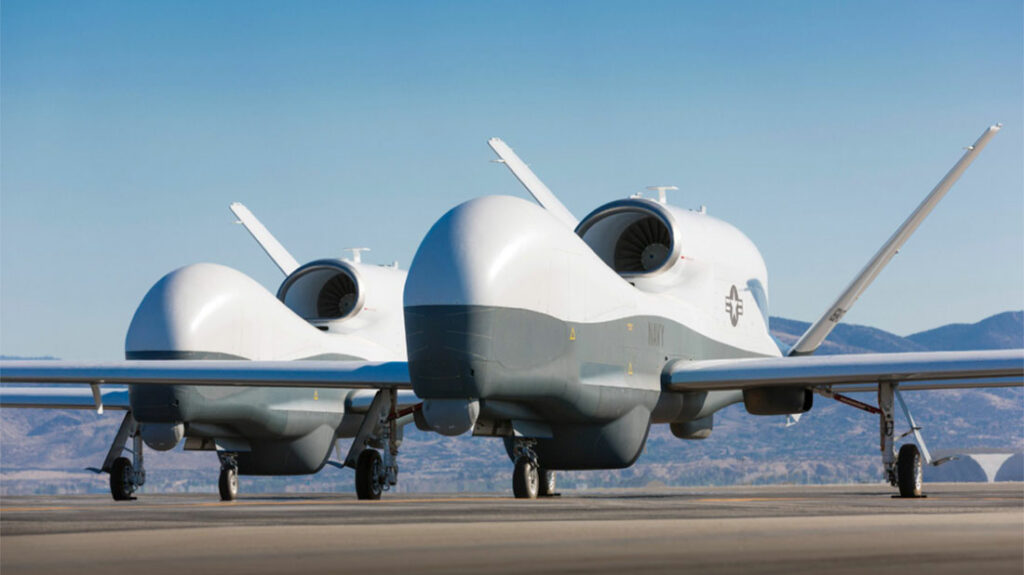Increasing Decisive Advantage: the X-band UAV

UAV operators and acquisition offices take note: not all beyond-line-of-sight UAVs are made the same. A certain breed, namely X-band UAVs, are far ahead of the rest in terms of all-weather, go anywhere, anytime can-do ISR and weapons delivery capability. And they offer less radio frequency (RF) interference to surrounding operations, and can do it all with lower operating costs than their Ku-band counterparts. In other words, X-band UAVs bring decisive advantages to military and all sorts of other operations. The all-weather capability and many other benefits of X-band UAVs are catching on – and are taking the industry by storm.
Take the US Navy’s MQ-4C Triton UAV, equipped with X-band SATCOM and de-icing capabilities, launching it far and away ahead of the Air Force’s RQ-4C Global Hawk in terms of all-weather performance (RQ-4 Global Hawk is a predecessor, yes, but a far inferior and less potent weapon system to be sure). Or take the UK’s Protector UAV, an especially potent, high-endurance, all-weather X-band variant of General Atomics’ venerable Sky Guardian UAV platform. With 9 external mounts vice 5 on its smaller MQ-9 Reaper cousin, the Protector UAV brings a particularly decisive, all-weather advantage to the UK’s combat capabilities.
X-band UAVs are coming quickly, but the benefits of X-band UAVs don’t stop with decisive all-weather capabilities. This week, let’s discuss the benefits of X-band UAVs in terms of (a) all-weather capability, (b) less RF splatter, and (c) lower operating costs.
All-Weather Capability. It is generally acknowledged that weather significantly attenuates radio frequencies above 10Ghz, making Ku- and especially Ka-band UAVs simply unsuitable for all-weather operations. And while extra bandwidth (“link margin”) and/or adaptive coding and modulation (ACM) techniques can attempt to repair a SATCOM link being damaged by high humidity, thunderstorms, sleet, driving snow, even airborne dust or sand, this technology – and the extra bandwidth required – costs significantly more money than what X-band, at 7.25 – 8.4 GHz, does naturally well. ISR and strike operations cannot wait for sunny weather – having an all-weather intelligence, surveillance, and reconnaissance (ISR) and/or strike capability is a critical key to mission success.
Less RF Splatter. Quite simply put, a Ku-band UAV in flight can cause a significant amount of RF interference known as “RF splatter” during turns and course corrections due to RF emissions that accidentally hit nearby Ku-band satellites, which are often positioned with just 2 degrees of orbital separation or less. X-band satellites, by contrast, are positioned with a minimum of 4 degrees of orbital separation or more, meaning that the risk of RF splatter is naturally less. Your time-sensitive intelligence and targeting data arrives intact while your communications networks stay up, so your mission stays on track. Like weatherproof SATCOM, having interference-free SATCOM is a key to mission success.
Lower Operating Costs. The wide satellite separation between X-band satellites permits X-band UAVs to transmit more efficiently, at higher spectral power densities, than their Ku-band counterparts. With efficiencies of .64 bits/Hz compared to .26 bits/Hz, X-band signals fired through a standard spot beam can achieve efficiencies 2.5 times greater than Ku-band even when fired through a High Throughput Satellite (HTS) system. This means less bandwidth and less cost to the customer, preserving limited financial resources for other important uses – like putting more steel on target.
X-band UAVs. More powerful. All weather. Less crippling to your SATCOM networks. And lower cost. How can we increase your decisive advantage?